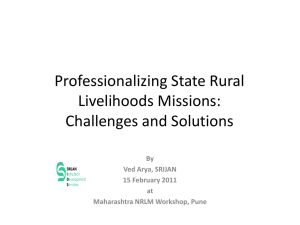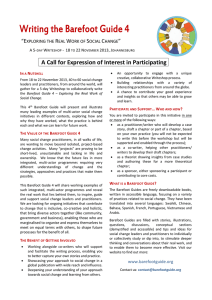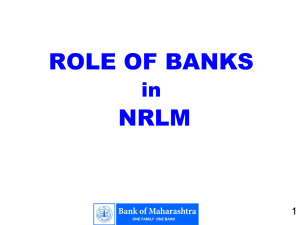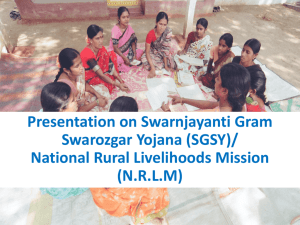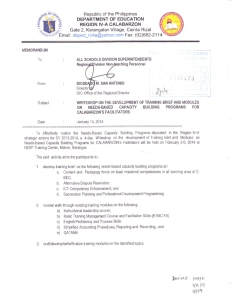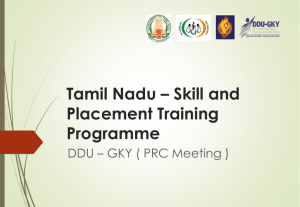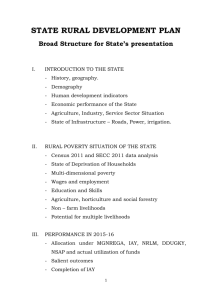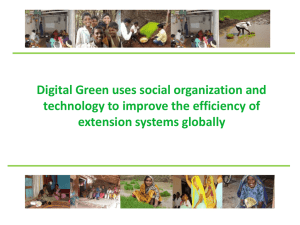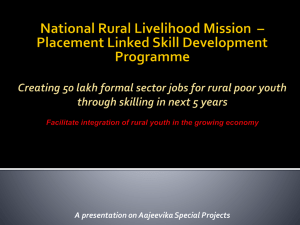Note - Writeshop_SRD - National Rural Livelihoods Mission
advertisement
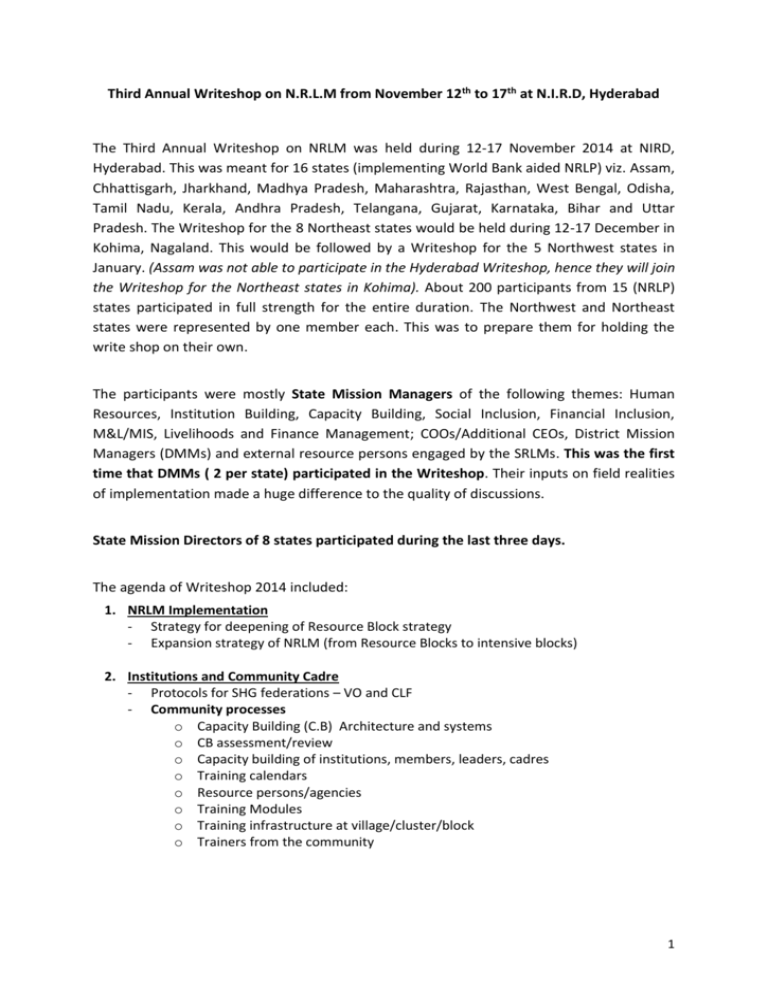
Third Annual Writeshop on N.R.L.M from November 12th to 17th at N.I.R.D, Hyderabad The Third Annual Writeshop on NRLM was held during 12-17 November 2014 at NIRD, Hyderabad. This was meant for 16 states (implementing World Bank aided NRLP) viz. Assam, Chhattisgarh, Jharkhand, Madhya Pradesh, Maharashtra, Rajasthan, West Bengal, Odisha, Tamil Nadu, Kerala, Andhra Pradesh, Telangana, Gujarat, Karnataka, Bihar and Uttar Pradesh. The Writeshop for the 8 Northeast states would be held during 12-17 December in Kohima, Nagaland. This would be followed by a Writeshop for the 5 Northwest states in January. (Assam was not able to participate in the Hyderabad Writeshop, hence they will join the Writeshop for the Northeast states in Kohima). About 200 participants from 15 (NRLP) states participated in full strength for the entire duration. The Northwest and Northeast states were represented by one member each. This was to prepare them for holding the write shop on their own. The participants were mostly State Mission Managers of the following themes: Human Resources, Institution Building, Capacity Building, Social Inclusion, Financial Inclusion, M&L/MIS, Livelihoods and Finance Management; COOs/Additional CEOs, District Mission Managers (DMMs) and external resource persons engaged by the SRLMs. This was the first time that DMMs ( 2 per state) participated in the Writeshop. Their inputs on field realities of implementation made a huge difference to the quality of discussions. State Mission Directors of 8 states participated during the last three days. The agenda of Writeshop 2014 included: 1. NRLM Implementation - Strategy for deepening of Resource Block strategy - Expansion strategy of NRLM (from Resource Blocks to intensive blocks) 2. Institutions and Community Cadre - Protocols for SHG federations – VO and CLF - Community processes o Capacity Building (C.B) Architecture and systems o CB assessment/review o Capacity building of institutions, members, leaders, cadres o Training calendars o Resource persons/agencies o Training Modules o Training infrastructure at village/cluster/block o Trainers from the community 1 - Systems in Community Institutions o Auditing – create community auditors, their capacity building o MIS in community institutions o Financial Management o Community HR o Community Procurement 3. SRLM Staff - Communitization: HR rationalization, Community cadres, mission in the hands of the community, AAP from ground - Staff (HR) structure in the SRLM o Job charts, role clarity o HR Hygiene, Delegation and Other HR issues/aspects/systems o Induction and Customized CB for Staff o Selection, de-selection o Rationalization of staff structure o Performance Review System o HR Code of Conduct - Capacity building of staff (building Self-reliant SRLMs) o Capacity building of staff at SMMU, DMMU, BMMU - Induction, thematic CB, customized CB o CB Architecture: Resource Persons, Agencies, Learning Forums/platforms, egroups o Mentors for staff o (Shared) Visioning to all levels 4. NRLM Systems and Processes - Annual Action Plan (AAP) 2015-16 - Streamlining Finance Management and Procurement systems in SRLMs - Procurement of MIS Agencies As part of the Writeshop, the participants worked in several combinations including being in the plenary, state-wise, groups of states, theme-wise, task-wise ‘write-teams’, and integrating groups. They interacted with the Mission leadership and mentors, discussed intensely, revised the draft documents, added additional notes, sought clarifications and endorsements for the indicative processes, timelines and protocols. The Writeshop infused a sense of solidarity among the staff of all the participating SRLMs. The Writeshop was successful in reinforcing NRLM core values, philosophy, processes, theory of change and non-negotiable principles. It also clarified key issues regarding phasing of the programme, staffing, capacity building of community institutions, community cadre and SRLM staff, PIP, AAP 2015-16, unit costs and finance management in the SRLMs. The Writeshop provided space for the states to share and learn from each other’s experience in NRLM implementation. Together, the states and the national team reflected on the strategies that proved fruitful and those that haven’t worked. Based on these deliberations, some key messages that are crucial in shaping the course of the Mission over 2 the coming year or two had emerged during the Writeshop. It is advised that the SRLMs adopt and assimilate this thinking into their systems for achieving better results on ground. The writeshop will enable more pro-active ‘horizontal learning’ across the states. Since best practices of different states were highlighted, it enabled the states to talk to each other and learn from each other. Our expectation is that this collaboration will go beyond the write shop. The key messages of the Writeshop are reiterated below. 1. Deepening Resource Blocks: It was agreed that the CRP rounds would continue in the Resource Blocks till all villages and NRLM target households are covered. Protocols for forming and strengthening VOs and CLFs (through Senior CRP Rounds), along with probable timelines for their sustainability were discussed and finalized. The SRLM, with the support of the NRO would identify and nurture social capital – Women Activists, Resource Bookkeepers and MCP trainers in good numbers. These cadres would be employed to deepen activities in the Resource Blocks, as well as to scale up NRLM in the newer blocks. Exposure visits to the NRO would be mandatory for the office bearers of newly formed VOs and CLFs. It was also suggested that block level staff must visit the NRO to learn best practices in VO and CLF management. Finally, exposure visits for branch managers of the local banks and other stakeholders was also thought necessary for ensuring their cooperation. 2. Transition to Intensive Blocks: The protocol for scaling up to intensive blocks was finalized. Each Resource Block which has completed 2.5 years of CRP rounds is expected to generate internal CRPs to service 10 blocks in the next 12 months. The following five states: Chhattisgarh, Jharkhand, Madhya Pradesh, Maharashtra and Rajasthan would be moving into this phase in 2015-16. The State Missions need to prepare well to make this happen in a seamless manner. The new blocks would be identified keeping mind the capacity of the Resource Block to service that block (in terms of availability of CRPs and other social capital). Further, the SRLM would prepare timelines for completion of work in an intensive block. The SRLMs would post the requisite staff: Block Mission Managers, Cluster Coordinators and one dedicated anchor at the district level to handle scaling up strategy in the intensive blocks. The SRLM would also engage in the capacity building of its staff (facilitated by the NRO) in the expansion strategy. 3 3. Communitisation: Based on the experience of the three years of NRLM, it has been realized that Communitisation is critical for NRLM to scale-up, for it to be a real movement and for the institutions to be sustainable. This would imply that HR of the SRLM is rationalized and the community institutions and community cadre would need to take over the activities presently handled by the Mission at various levels. NRLM has firm belief that community has immense potential to take over these activities and deliver. They not only have the complete understanding of the local socio-cultural ethos but have also better acceptability among the community. Communitisation would help the mission to lay a strong foundation for sustainable institutions as the community cadre would be able to give more time and a better hand holding support. Also, the community cadre would have more accountability towards the community and its institutions. 4. Community Institutions to Serve as Resource Organisations: The Writeshop appreciated the leading role that community institutions, community cadre and CRPs have played in implementing NRLM in 18 new States. Keeping this in mind, it was recommended that the CLFs/BLFs be recognized as Resource Organisations. At present, 4 advanced SRLMs (AP, Telangana, Kerala and Bihar) have been identified as National Resource Organisations (NROs). The Writeshop agreed that as part of the communitisation process, the role of these SRLMs as NROs must be transferred to the community institutions. To begin with, the SRLMs would enter into a 3-year agreement with the C.B.Os Mahasamakhyas or C.L.F s or their equivalent in the NRO states to deepen NRLM interventions in Resource Blocks and to prepare the CLFs/BLFs in each Resource Block to service the mobilization and capacity needs of 15-20 newer blocks. Over the next 3 years, as the CLFs/BLFs in the Resource Blocks mature, the SRLMs must utilize their services for scaling up within the state. The federations would graduate from being local resource organisations to State Resource Organisations (SROs), National Resource Organisations (NROs) and in the future even International Resource Organisations (IROs), as the scale of their operations grows. 5. Disbursement of Vulnerability Reduction fund: NRLM provides a fund of Rs. 1500/member to the VO (or Primary Level Federation) as a Vulnerability Reduction Fund (VRF) towards mitigating vulnerabilities of specific members or the community in general. Some indicative criteria for disbursing this fund to the institutions emerged during the Writeshop. They are as follows: o o o o VO must have completed 3 monthly meetings VOEC members should have been trained on VRF concept. VO should have a saving bank A/c. VO should have up-to-date books of accounts - Minute book, Cash Book loan ledger. 4 o VO assistant (VO Book Keeper) should have been appointed and have received training on management. o VO should have prepared an indicative list of vulnerabilities of village. o A VRF subcommittee should have been constituted and members of subcommittee must have received training on roles & responsibility about VRF. The VRF is a resource in perpetuity provided to the VO to address the vulnerabilities faced by its members. The rate of interest and repayment schedules may be relaxed to suit the needs of the members. (Detailed guidelines on VRF disbursement would be issued shortly). 6. Participatory Identification of Poor in two stages: PIP would be done in two stages. The first stage would be conducted by the CRPs during the mobilization drive. CRPs, having experienced poverty themselves and having been trained in identifying poor are capable of conducting the PIP process. Additionally, they would be given some training in the PIP method to bolster their skills. When the VO comes into being in the village/hamlet, it will take over the responsibility of conducting the PIP at regular intervals to include any left out poor. 7. SRLM HR Rationalisation: HR Rationalization at the state, district and block levels has emerged as a clear and immediate agenda. It was felt that the existing staff at the district and state levels must concentrate on implementing and deepening interventions in the Resource Blocks. Further, it was concluded that at least in this critical stage of moving from Resource Blocks to intensive blocks, specializations at the state, district and block level need to be collapsed and all staff should have area responsibility as their primary responsibility. They need to be in the field majority/most of the time including field stays in the villages, being with and listening to community. Therefore, SRLMs need to freeze any further recruitment and focus on lateral or vertical movement of the staff which is inducted, trained and committed in NRLM processes. SRLMs must avoid having staff for layering initiatives in advance at the state and district levels. Recruitment of these positions should correspond to layering interventions being introduced in the blocks, starting with Resource Blocks. 8. Unit Costs Recommendations: Revisions in the cost norms for the SRLMs were recommended on the basis of the changes suggested in the implementation strategy. The decision to collapse specialization of staff at district and state levels has certain implications on the unit costs and financial management system. Considering that state and district staff would be spending a greater part of the 5 month in the Resource Blocks, it was recommended that all costs incurred on them (remuneration and allowances) be booked under block costs. The start-up costs provided to the VO and CLF must be considered as funds to the community and not as a Capacity Building cost. Further, the SRLMs may decide to disburse this fund over one or more years, depending on the need of the institutions in their respective states. Way Forward It is suggested that all the SRLMs adapt the revised COM, Community Capacity Building Modules, Model HR Manual and Staff Capacity Building Modules to their local context and duly implement them. SRLMs are also directed to prepare their Annual Action Plans (AAPs) 2015-16 according to the revised AAP template. The AAPs must be in line with the outlines presented to the Additional Secretary (RL)/National Mission Director (NMD) during the Writeshop. 6
